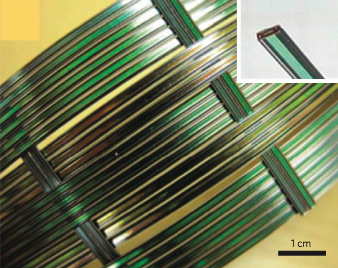US scientists create cloth that can listen, produce sound
Source: alternet.org

This could give a whole new meaning to the phrase power dressing. Scientists at the Massachusetts Institute of Technology have created a cloth that can hear and emit noise.
The development, described in the August issue of Nature Materials, transforms the usual passive nature of textiles into a virtually all-singing, all-dancing version.
The team, led by MIT professor Yoel Fink, has reached "a new milestone on the path to functional fibers: fibers that can detect and produce sound," MIT said in a statement.
The development, described in the August issue of Nature Materials, transforms the usual passive nature of textiles into a virtually all-singing, all-dancing version.
According to MIT, "applications could include clothes that are themselves sensitive microphones, for capturing speech or monitoring bodily functions, and tiny filaments that could measure blood flow in capillaries or pressure in the brain."
The decade-old research project aims to "develop fibers with ever more sophisticated properties, to enable fabrics that can interact with their environment," MIT said.
The new space-age cloth, it said, can not only listen, but make sound.
"You can actually hear them, these fibers," Noemie Chocat, part of the lab team, said.
"If you connected them to a power supply and applied a sinusoidal current, then it would vibrate. And if you make it vibrate at audible frequencies and put it close to your ear, you could actually hear different notes or sounds coming out of it."
The new fibers are based on a similar plastic to that used in microphones.
However, researchers manipulated the fluorine content to ensure its molecules stayed lopsided. That imbalance makes the plastic piezoelectric, meaning it changes shape when an electric field is applied.
"In addition to wearable microphones and biological sensors, applications of the fibers could include loose nets that monitor the flow of water in the ocean and large-area sonar imaging systems with much higher resolutions," MIT said.
"A fabric woven from acoustic fibers would provide the equivalent of millions of tiny acoustic sensors."
Article from: Alternet.org
MIT produces fibers that can speak, hear
By Stephen Shankland| News.CNET.com

Different-shaped fibers can emit sounds in a variety of ways. (Credit: MIT)
The walls have ears, the saying goes--but at some point, so might people’s clothes. With the help of fiber research at MIT, fabrics of the future could both hear and make noises.
Yoel Fink, an assistant professor at the Massachusetts Institute of Technology, and his colleagues developed fibers that are active where most are passive. Specifically, through a new application of widely used technology called piezoelectrics, fibers can convert sound waves into an electrical signal and vice versa, MIT announced Monday.
Piezoelectric speakers have been around for a long time--beeping digital watches and those musical greeting cards use them, for example--but Fink’s approach uses fibers instead of a flat speaker. Key to the approach is making the fibers so that one side is different from the other, rather than being symmetric.
One edge of the fiber has more fluorine atoms running along it, and the other has more hydrogen atoms. This difference is responsible for the connection between the fibers’ movement--whether caused by sound or causing it--and its electrical properties.

A sample of the MIT piezoelectric fibers that shows their dimensions. (Credit: MIT)
"Fabrics woven from piezoelectric fibers could be used as a communication transceiver," the researchers wrote, describing their approach in the July 11 issue of Nature Materials.
Sound isn’t the only sensitivity possible with smarter fabrics. MIT also has worked on cameralike fibers sensitive to light.
The fibers aren’t easy to make. They’re produced from much larger cylinders that are "drawn" through a small aperture at higher temperatures. The MIT group managed the task using a number of techniques, including the use of an electrically conducting graphite-based plastic and a strong electric field to align necessary molecules.
Don’t expect walking boom boxes anytime soon, though. Besides manufacturing and other practical constraints, the fibers today work only with kilohertz to megahertz sound frequencies, and humans employ much lower frequencies.
Article from: news.cnet.com






















